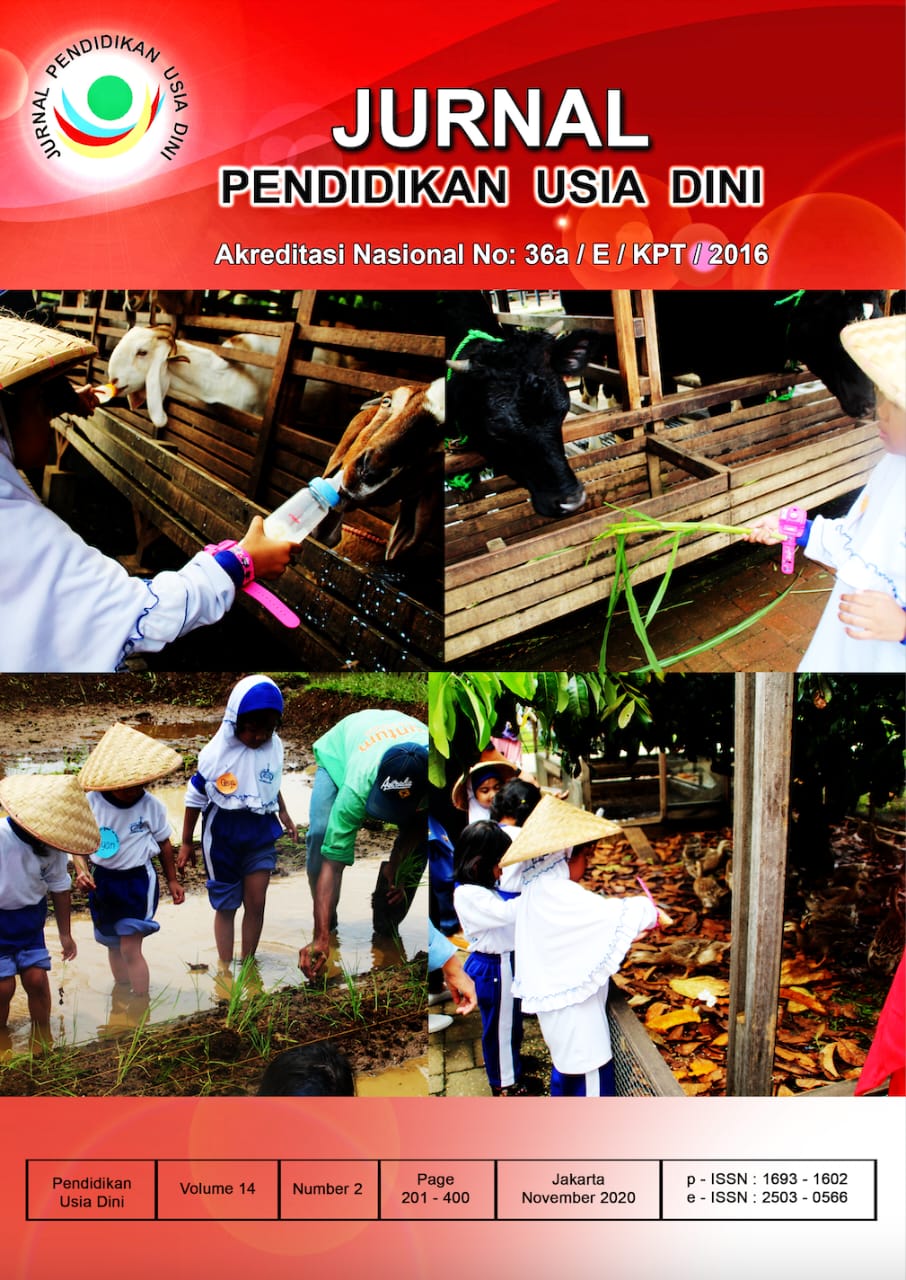E-Comic: Media for Understanding Flood Disaster Mitigation in Early Childhood Education
DOI:
https://doi.org/10.21009/JPUD.142.12Abstract
The existence of several early childhood education institutions in Indonesia, such as in the Riau Province region, often faces the risk of catastrophic floods overflowing the Kampar River resulting in casualties. The results of preliminary research found that children lacked insight into flood disaster mitigation, and schools did not have appropriate mitigation programs or media. This study aims to develop a product in the form of an E-Comic to introduce flood disaster mitigation in a practical and effective early childhood education. Research and development procedures in this study using the ADDIE model. The data collection techniques for this study were the results of expert validation, practicality tests, and media effectiveness tests on children aged 5-6 years using the mitigation understanding instrument and descriptive statistical analysis of Aiken's V validation. Flood disaster is very suitable for use in early childhood learning, with the average Aiken's V result by material experts is 89% and media expert is 96%. E-Comic practicality with an average percentage of 85.5% and effectiveness test results with an average value of 90%. It can be concluded that the E-Comic introduction of flood disaster mitigation in Kindergarten children is suitable for use as a learning medium and has a practical and effective quality.
Keywords: E-Comic, Flood Disaster Mitigation
References:
Apriyani, R., Sumarni, S., & Rukiyah, R. (2018). Pengembangan Media Pembelajaran Komik Tema Alam Semesta untuk Anak. Cakrawala Dini: Jurnal Pendidikan Anak Usia Dini, 9(2), 110–124. https://doi.org/10.17509/cd.v9i2.11004
Azizah, N., & Khanafiyah, S. (2014). Pengaruh Komik Sains dalam Pembelajaran IPA terhadap Pengembangan Karakter Siswa di Kecamatan Semarang Tengah. 3(3), 34–42. https://doi.org/10.15294/upej.v3i3.4329
Bolton-Gary, C. (2012). Connecting Through Comics: Expanding Opportunities for Teaching and Learning. 7.
Branch, R. M. (2009). Instructional Design: The ADDIE Approach. Springer US. https://doi.org/10.1007/978-0-387-09506-6
Courtis, A. (2012). Tech Module: Using Comic Life in the Classroom. 61.
- S. Syarah, E. Yetti, L. Fridani, Yufiarti, Hapidin, B. Pupala. (2019). Electronic Comics in Elementary School Science Learning for Marine Conservation. Jurnal Pendidikan IPA Indonesia, 8(4). https://doi.org/10.15294/jpii.v8i4.19377
Ersoy, Ş., & Koçak, A. (2016). Disasters and earthquake preparedness of children and schools in Istanbul, Turkey. Geomatics, Natural Hazards and Risk, 7(4), 1307–1336. https://doi.org/10.1080/19475705.2015.1060637
Haynes, K., & Tanner, T. M. (2015). Empowering young people and strengthening resilience: Youth-centred participatory video as a tool for climate change adaptation and disaster risk reduction. Children’s Geographies, 13(3), 357–371. https://doi.org/10.1080/14733285.2013.848599
Permendikbud no 137, Pub. L. No. no 137 (2014).
Kousky, C. (2016). Impacts of Natural Disasters on Children. The Future of Children, 26(1), 73–92. https://doi.org/10.1353/foc.2016.0004
Lopez, Y., Hayden, J., Cologon, K., & Hadley, F. (2012). Child participation and disaster risk reduction. International Journal of Early Years Education, 20(3), 300–308. https://doi.org/10.1080/09669760.2012.716712
Martin, M.-L. (2010). Child Participation in Disaster Risk Reduction: The case of flood-affected children in Bangladesh. Third World Quarterly, 31(8), 1357–1375. https://doi.org/10.1080/01436597.2010.541086
Melliou, K., Moutafidou, A., & Bratitsis, T. (2014). Digital Comics Use to Develop Thinking Dispositions in Early Childhood Education. 2014 IEEE 14th International Conference on Advanced Learning Technologies, 502–504. https://doi.org/10.1109/ICALT.2014.148
Mitchell, T., Tanner, T., & Haynes, K. (2009). Children as agents of change for Disaster Risk Reduction: Lessons from El Salvador and the Philippines. 48.
Peek, L. (2008). Children and Disasters: Understanding Vulnerability, Developing Capacities, and Promoting Resilience—An Introduction. Understanding Vulnerability, 30.
Pfefferbaum, B., Pfefferbaum, R. L., & Van Horn, R. L. (2018). Involving children in disaster risk reduction: The importance of participation. European Journal of Psychotraumatology, 9(sup2), 1425577. https://doi.org/10.1080/20008198.2018.1425577
Save the Children UK. (2006). Child Protection During Floods in Bangladesh. The Save the Children Fund.
Schipper, L., & Pelling, M. (2006). Disaster risk, climate change and international development: Scope for, and challenges to, integration: Disaster Risk, Climate Change and International Development. Disasters, 30(1), 19–38. https://doi.org/10.1111/j.1467-9523.2006.00304.x
Syarah, E. S., Yetti, E., & Fridani, Lara. (2018). Pengembangan Media Komik Elektronik untuk Meningkatkan Pemahaman Konservasi Kelautan Anak Usia Dini. 12, 10.
Tanner, T. (2010). Shifting the Narrative: Child-led Responses to Climate Change and Disasters in El Salvador and the Philippines: Child-led Responses to Climate Change and Disasters. Children & Society, 24(4), 339–351. https://doi.org/10.1111/j.1099-0860.2010.00316.x
Tuladhar, G., Yatabe, R., Dahal, R. K., & Bhandary, N. P. (2014). Knowledge of disaster risk reduction among school students in Nepal. Geomatics, Natural Hazards and Risk, 5(3), 190–207. https://doi.org/10.1080/19475705.2013.809556
Versaci, R. (2001). How Comic Books Can Change the Way Our Students See Literature: One Teacher’s Perspective. The English Journal, 91(2), 61. https://doi.org/10.2307/822347
Wasliyah, S. (2018). Komik Bencana Meningkatkan Sikap Kesiapsiagaan Bencana pada Anak Sekolah Dasar Negeri Bulakan Kecamatan Gunung Kencana Banten Selatan Tahun 2017. Jurnal Medikes (Media Informasi Kesehatan), 5(1), 30–39. https://doi.org/10.36743/medikes.v5i1.39
Downloads
Published
How to Cite
Issue
Section
License
JURNAL PENDIDIKAN USIA DINI work is licensed under a Creative Commons Attribution 4.0 International License. (http://creativecommons.org/licenses/by/4.0/)





